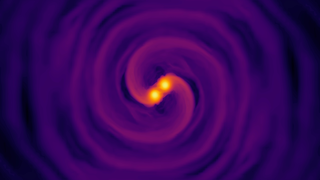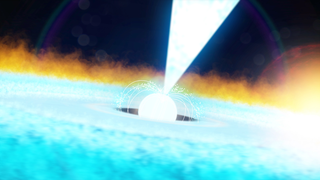Universe
ID: 11804
For pulsars like SAX J1808.43658 (SAX J1808 for short), gas channeled onto the neutron star’s magnetic poles creates hot spots that produce intense X-rays. The pulsar spins 401 times a second, and orbiting X-ray telescopes detect strong pulses when these hot spots wheel into view from Earth.
But there's another signal as well — an X-ray flickering known as a quasi-periodic oscillation, or QPO, that hovers around certain frequencies. For SAX J1808, the QPO varies up to 700 times a second.
Observations from NASA's Rossi X-ray Timing Explorer (RXTE) have shown that the pulses and the QPO have a direct relationship, providing insight into the inner structure of the accretion disk. X-ray pulses from the hot spots shine twice as bright when the QPO frequency matches or is faster than the pulsar’s spin, and their brightness dims by the same amount when the QPO fluctuates more slowly than the pulsar’s rotation. RXTE observed these changes during outbursts in 2002, 2005, and 2008.
This result strongly suggests that the QPO is a region of especially hot plasma near the inner edge of the accretion disk and that its fluctuations trace its orbital motion. When the QPO orbits more slowly than the neutron star’s spin, the flow of matter onto the pulsar becomes inhibited by the pulsar’s magnetic field. During an outburst, the inner edge of the disk is forced closer to the pulsar, resulting in a faster-moving QPO and compression of the magnetic field. When the QPO matches or bests the pulsar’s spin, the flow of matter onto the neutron star is enhanced, with more gas reaching the magnetic poles to brighter pulses. During these episodes, matter may also flow directly onto the pulsar's equatorial regions (lateral accretion).
RXTE Data Link Pulsar Pulses with a QPO
But there's another signal as well — an X-ray flickering known as a quasi-periodic oscillation, or QPO, that hovers around certain frequencies. For SAX J1808, the QPO varies up to 700 times a second.
Observations from NASA's Rossi X-ray Timing Explorer (RXTE) have shown that the pulses and the QPO have a direct relationship, providing insight into the inner structure of the accretion disk. X-ray pulses from the hot spots shine twice as bright when the QPO frequency matches or is faster than the pulsar’s spin, and their brightness dims by the same amount when the QPO fluctuates more slowly than the pulsar’s rotation. RXTE observed these changes during outbursts in 2002, 2005, and 2008.
This result strongly suggests that the QPO is a region of especially hot plasma near the inner edge of the accretion disk and that its fluctuations trace its orbital motion. When the QPO orbits more slowly than the neutron star’s spin, the flow of matter onto the pulsar becomes inhibited by the pulsar’s magnetic field. During an outburst, the inner edge of the disk is forced closer to the pulsar, resulting in a faster-moving QPO and compression of the magnetic field. When the QPO matches or bests the pulsar’s spin, the flow of matter onto the neutron star is enhanced, with more gas reaching the magnetic poles to brighter pulses. During these episodes, matter may also flow directly onto the pulsar's equatorial regions (lateral accretion).
Related
Credits
Michael Lentz (USRA): Lead Animator
Scott Wiessinger (USRA): Producer
Francis Reddy (Syneren Technologies): Writer
Tod Strohmayer (NASA): Scientist
Scott Wiessinger (USRA): Producer
Francis Reddy (Syneren Technologies): Writer
Tod Strohmayer (NASA): Scientist
Please give credit for this item to:
NASA's Goddard Space Flight Center Conceptual Image Lab
NASA's Goddard Space Flight Center Conceptual Image Lab
Science Paper:
Pulse Amplitude Depends on kHz QPO Frequency in the Accreting Millisecond Pulsar SAX J1808.4-3658
Short URL to share this page:
https://svs.gsfc.nasa.gov/11804
Mission:
RXTE
This item is part of this series:
Astrophysics Animations
Keywords:
SVS >> Neutron Star
SVS >> X-ray
SVS >> Astrophysics
SVS >> Pulsar
SVS >> Space
SVS >> Binary Star
SVS >> Star
SVS >> RXTE
NASA Science >> Universe
Pulse Amplitude Depends on kHz QPO Frequency in the Accreting Millisecond Pulsar SAX J1808.4-3658
Short URL to share this page:
https://svs.gsfc.nasa.gov/11804
Mission:
RXTE
This item is part of this series:
Astrophysics Animations
Keywords:
SVS >> Neutron Star
SVS >> X-ray
SVS >> Astrophysics
SVS >> Pulsar
SVS >> Space
SVS >> Binary Star
SVS >> Star
SVS >> RXTE
NASA Science >> Universe













